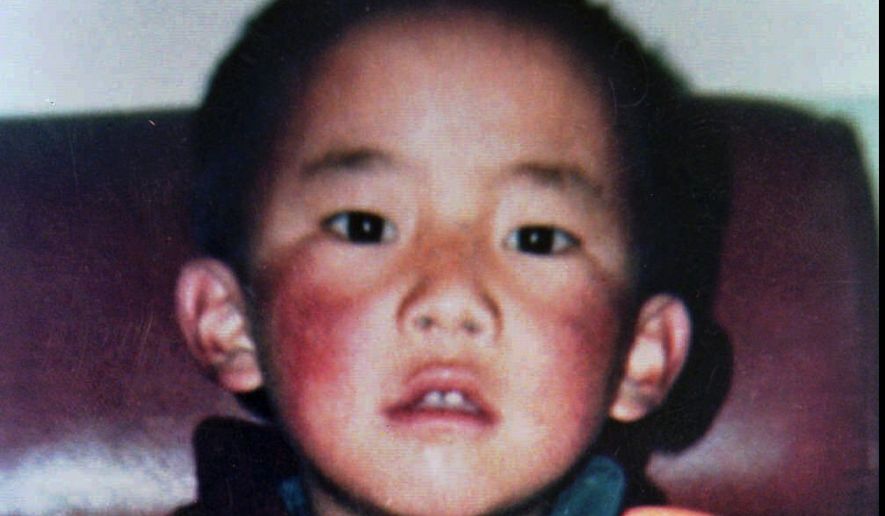BANGKOK — The Dalai Lama identified a little boy more than two decades ago as the reincarnation of the Tibetan Buddhist Panchen Lama and said he would one day emerge as the faith’s spiritual leader.
But before the world could ever know him, the boy was taken captive by Chinese authorities at age 6.
The fate of Gedhun Choekyi Nyima made global headlines as Tibetans celebrated his 30th birthday late last month, and the issue of Chinese meddling in Tibet has been thrust to the forefront.
Artist renderings of what the boy might look like today are swirling through media, rankling Beijing and inspiring Tibet.
Two new “portraits” of the figure whom Tibetan Buddhists call the Panchen Lama are at the center of a campaign supported by the Dalai Lama and the U.S. government-funded Radio Free Asia.
The hypothetical images are proving sensitive for China, which has a history of responding harshly to any foreign dealings with Tibetan spiritual leaders, such as the 83-year-old Dalai Lama, and sees the portraits as symbols of resistance to Chinese rule over the landlocked Central Asian region.
The Dalai Lama left Tibet, his homeland, in 1959 and helped establish a kind of government in exile in northern India. Gedhun Choekyi Nyima’s life has been entangled in that drama since 1995.
“Despite China’s sporadic claims that he was attending school and leading a normal life, no one has seen or heard from the 11th Panchen Lama Gedhun Choekyi Nyima since May 17, 1995, the day Beijing took him away as a 6-year-old boy and rendered him disappeared ever since,” according to a report by the Tibetan Bulletin, published by the government in exile.
Recognizing the Panchen
Mr. Nyima was born in Chinese-controlled Tibet on April 25, 1989. Chinese leaders have pushed their own candidate for the Panchen Lama, named by regime-friendly Buddhists leaders, but most Tibetans look to the long-missing Mr. Nyima as the legitimate heir to their spiritual throne.
“The Panchen Lamas and the Dalai Lamas play a significant role in the recognition of each other’s reincarnation when they are in a position to do so, although it is neither mandatory nor indispensable,” said the India-based Central Tibetan Administration.
The Dalai Lama and the Panchen Lama are believed to be incarnations of Buddha in different versions. The Buddha of Compassion is said to be reincarnated as the Dalai Lama, and the Buddha of Boundless Light becomes the Panchen Lama.
The 10th Panchen Lama died under mysterious circumstances in 1989, the same year Mr. Nyima was born to a doctor and nurse in Tibet.
It wasn’t until May 14, 1995, that the Dalai Lama announced his recognition as the Panchen Lama’s 11th reincarnation. Three days later, China took the child and his family into custody and, critics say, induced compliant Tibetan Buddhist clergy to declare another Tibetan boy, Gyaltsen Norbu, as the genuine reincarnation.
The Dalai Lama fled his lavish Potala Palace in Tibet, with help from the CIA, during a communist Chinese assault on Tibet in the late 1950s. Much to the fury of officials in Beijing, the Dalai Lama has spent his life in exile traveling the world to demand greater autonomy for his former homeland.
Chinese officials “say they are waiting for my death and will recognize a 15th Dalai Lama of their choice,” the Dalai Lama wrote in 2011.
’Prisoner of conscience’
To highlight Mr. Nyima’s disappearance and celebrate his 30th birthday, the International Tibet Network’s political prisoners campaign working group commissioned artist Tim Widden to create a speculative portrait of him as an adult for a BBC film titled “Where Is the 11th Panchen Lama?”
Mr. Widden’s age progression image was based on a color photo of Mr. Nyima as a child — the only known picture of him.
“Widden says he had to assume average health and average weight, though it could easily be that he is emaciated,” the BBC said. “He also had to guess at a hairstyle.”
The U.S. government’s Radio Free Asia published on its website a different portrait by its own artist depicting what the boy might look like as a 30-year-old.
Rep. James P. McGovern, Massachusetts Democrat, said the drawings are useful to spotlight the fact that the Panchen Lama “will mark his 30th birthday as one of the world’s longest-held prisoners of conscience.”
“The enforced disappearance of the 11th Panchen Lama is an egregious example of the Chinese government’s violation of the religious freedom of Tibetan Buddhists, who have the right to choose their own religious leaders without government interference,” the congressman said late last month. “The [Chinese] government’s designation of an alternative Panchen Lama merely victimized another young person as a consequence of its policies to undermine and control the Tibetan people.”
Mr. McGovern is co-chair of the congressional Tom Lantos Human Rights Commission and the chairman of the Congressional-Executive Commission on China, a bipartisan group that monitors China’s human rights record, adherence to the rule of law and record on political prisoners.
“How can a [communist] government that does not have faith in religion claim to interfere in the reincarnation of the Panchen Lama?” asked Youdon Aukatsang, a member of Tibet’s parliament in exile at the Dalai Lama’s Himalayan headquarters in Dharamsala, India.
Observances of Mr. Nyima’s 30th birthday have spurred a new wave of activism on his behalf, along with speculation about his treatment and his location.
“It is believed he is still alive,” the Washington-based International Campaign for Tibet said in a statement marking the anniversary of his birth. “As the Panchen Lama turns 30, the ICT calls on China to immediately free him and allow him to return to his monastery, Tashi Lhunpo, and assume his vital role as a religious leader.”




Please read our comment policy before commenting.